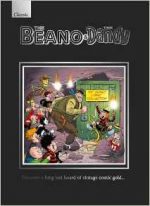
By George Herriman, edited by Bill Blackbeard (Fantagraphics Books)
ISBN: 978-1-56097-386-7
The cartoon strip starring Krazy Kat is quite possibly the pinnacle of graphic narrative innovation; a hugely influential body of work which shaped the early days of the comics industry and became an undisputed treasure of world literature.
Krazy and Ignatz, as it is dubbed in these glorious commemorative collected tomes from Fantagraphics, is a creation which can only be appreciated on its own terms. It developed a unique language – at once both visual and verbal – and dealt with the immeasurable variety of human experience, foibles and peccadilloes with unfaltering warmth and understanding without ever offending anybody.
Sadly, however, it baffled far more than a few…
It was never a strip for dull, slow or unimaginative people who simply won’t or can’t appreciate the complex multilayered verbal and pictorial whimsy, absurdist philosophy or seamless blending of sardonic slapstick with arcane joshing. It is still the closest thing to pure poesy that narrative art has ever produced.
Herriman was already a successful cartoonist and journalist in 1913 when a cat and mouse who had been cropping up in his outrageous domestic comedy strip The Dingbat Family/The Family Upstairs graduated to their own feature. Krazy Kat debuted in William Randolph Hearst’s New York Evening Journal on Oct 28th 1913 and – largely by dint of the publishing magnate’s overpowering direct influence and interference – gradually spread throughout his vast stable of papers.
Although Hearst and a host of the period’s artistic and literary intelligentsia (notably – but not exclusively – e.e. Cummings, Frank Capra, John Alden Carpenter, Gilbert Seldes, Willem de Kooning, H.L. Mencken and – later – Jack Kerouac) all adored the strip, many local and regional editors did not; taking every potentially career-ending opportunity to drop it from the comics section.
Eventually the feature found a home and safe haven in the Arts and Drama section of Hearst’s papers. Protected there by the publisher’s heavy-handed patronage, the Kat flourished unharmed by editorial interference and fashion, running generally unmolested until Herriman’s death in April 1944.
The basic premise is simple: Krazy is an effeminate, dreamy, sensitive and romantic feline of indeterminate gender hopelessly in love with Ignatz Mouse: rude crude, brutal, mendacious and thoroughly scurrilous.
Ignatz is a true unreconstructed male; drinking, stealing, fighting, conniving, constantly neglecting his wife and children and always responding to Krazy’s genteel advances by clobbering the Kat with a well-aimed brick (obtained singly or in bulk from noted local brick-maker Kolin Kelly) which the smitten kitten invariably misidentifies as tokens of equally recondite affection.
The third crucial element completing an anthropomorphic eternal triangle is lawman Offissa Bull Pupp, who is completely besotted with Krazy, professionally aware of the Mouse’s true nature, yet hamstrung – by his own amorous timidity and sense of honour – from removing his devilish rival for the foolish feline’s affections.
Krazy is, of course, blithely oblivious to Pupp’s dilemma…
Also populating the ever-mutable stage are a stunning supporting cast of inspired bit players such as dreaded deliverer of unplanned, and generally unwanted, babies Joe Stork; hobo Bum Bill Bee, unsavoury conman and trickster Don Kiyoti, busybody Pauline Parrot, self-aggrandizing Walter Cephus Austridge, inscrutable – often unintelligible – Chinese mallard Mock Duck, dozy Joe Turtil and a host of other audacious characters all equally capable of stealing the limelight and even supporting their own features.
The exotic, quixotic episodes occur in and around the Painted Desert environs of Coconino (based on the artist’s vacation retreat in Coconino County, Arizona) where surreal playfulness and the fluid ambiguity of the flora and landscape are perhaps the most important member of the cast.
The strips themselves are a masterful mélange of unique experimental art, wildly expressionistic and strongly referencing Navajo art forms whilst graphically utilising sheer unbridled imagination and delightfully evocative lettering and language: alliterative, phonetically and even onomatopoeically joyous with a compelling musical force (“Soff, soff brizzâ€, “l’il dahlink†or “Ignatz, ware four is thou at Ignatz??â€).
Yet for all that, the adventures are poetic, satirical, timely, timeless, bittersweet, self-referential, fourth-wall bending, eerie, idiosyncratic, astonishingly hilarious escapades encompassing every aspect of humour from painfully punning shaggy dog stories to riotous, violent slapstick. Sometimes Herriman even eschewed his mystical mumblings and arcane argots for the simply sublime grace of a silent gag in the manner of his beloved Keystone Cops…
There have been numerous Krazy Kat collections since the late 1970s when the strip was rediscovered by a better-educated, open-minded and far more accepting audience. This fabulous forth tome – covering 1925-1926 in a comfortably hefty (231 x 15 x 305 mm) softcover edition returns the strip to its monochrome roots and offers added value as context, background and possible explanations are delivered by the much-missed Bill Blackbeard in his effusive essay ‘By George, It’s Krazy’ before a second text “found-feature†exploits Herriman’s journalistic gifts with contemporary movie reviews delivered by “Thet Ket†in ‘“The Gold Rush†as Seen by Krazy Kat’ and ‘Krazy Kat Sees Miss Davies in “Janice Meredith‒ as both prose and cartoon critiques…
On to the strips then: within this compelling compendium of incessant passions thwarted in another land and time the unending drama plays out as usual, but with some of those intriguing supplementary characters increasing coming to the fore.
We open with the change of years bringing a few weeks’ worth of weird ruminations on the nature of time before Ignatz’s continual search for his ammunition of choice leads to many brick-based gags and his occasional fleecing by Coconino’s copious coterie of confidence tricksters.
Of course the mouse is a man who enjoys revenge served hot, cold or late…
As well as increased roles for the Kat’s cousins Krazy Katfish and Krazy Katbird there is more involvement for Joe Stork, who expands out of the exclusive delivery of (generally unwanted) babies into the hooch-dissemination business during those heady days of Prohibition, as well the introduction of tail-less Manx Cat and a Krazy cow.
As expected there is a solid dependence on the strange landscapes and eccentric flora for humorous inspiration. Moreover in the Jazz Age of Technological Marvels the mouse frequently takes to the skies to deliver his brain-busting bon mots…
The dangerous delights of Piñatas are introduced to American readers and there’s a healthy dose of surrealism after certain elephantine geological features come to life, whilst Krazy’s Kool is at last lost once Ignatz begins baking his own bricks and cutting Kolin Kelly out of the mounting fiscal equation. Once rubber trees start popping up all over the landscape, nobody is truly safe from the consequences of escalating slapstick silliness…
The year then concludes with uncharacteristic chills and spills when Coconino is subjected to sudden squalls of snow which lead inevitably to too much water as 1926 opens cold and crisp and sodden…
Herriman incorporated his love of cinema here by introducing an itinerant film crew to the cast and began playing even more with his audience and the Fourth Wall after one of the cartoon regulars swiped all the black ink leaving the rest of the cast in a deeply diminished state of embellishment.
The infinitely inventive scribbler also created a bigger role for Mock Duck who temporarily quit the laundry business to set up as a psychic prognosticator and surly seer whilst poor Pupp began to slowly gain the upper paw in the turbulent triangular relationship…
Krazy, meanwhile, discovered a previously unsuspected – and apparently genetically predisposed – affinity for lighting and electricity which the rest of the cast were able to share but not enjoy…
Also always on offer are wry cartoon commentaries on the increasingly technological advancement of the nation, seasonal landmarks and the evergreen fodder of unwanted kids and illegal drinking as well as more pomposity punctured and penny-pinching money-making schemes from the town’s great and good always coming to nothing…
…And sometimes plain mischief rules, such as when Herriman pictorially plays hob with the laws of physics just to see what will happen…
Wrapping up the cartoon gold is another erudite and instructional ‘Ignatz Mouse Debaffler Page’, providing pertinent facts, snippets of contextual history and necessary notes for the young and potentially perplexed.
Herriman’s epochal classic is a phenomenal achievement: in all the arenas of Art and Literature there has never been anything like these comic strips which have shaped our industry and creators, and inspired auteurs in fields as disparate as prose fiction, film, dance, animation and music, whilst delivering delight and delectation to generations of wonder-starved fans.
If, however, you are one of Them and not Us, or if you actually haven’t experienced the gleeful graphic assault on the sensorium, mental equilibrium and emotional lexicon carefully thrown together by George Herriman from the dawn of the 20th century until the dog days of World War II, this glorious compendium is a most accessible way to do so. Heck, it’s even available as an eBook now so don’t waste the opportunity…
© 2002 Fantagraphics Books. All rights reserved.











